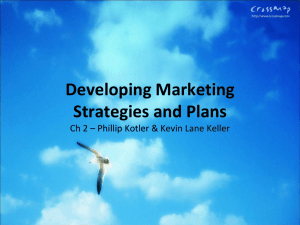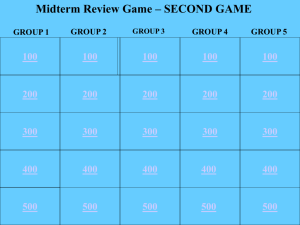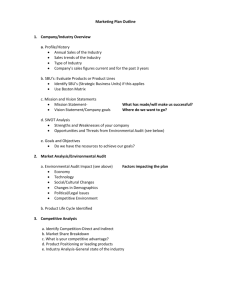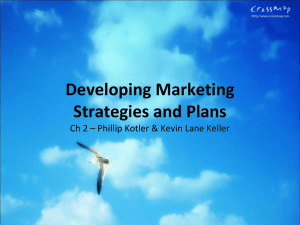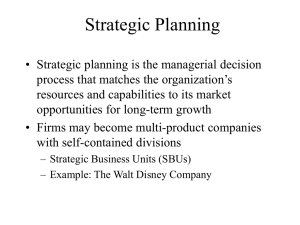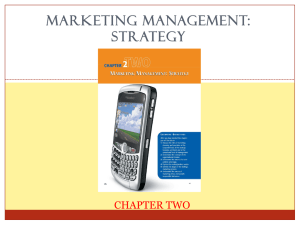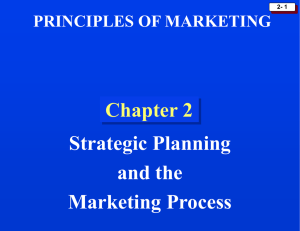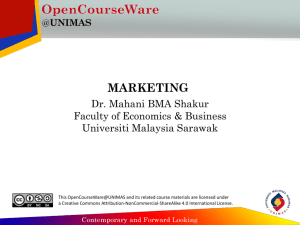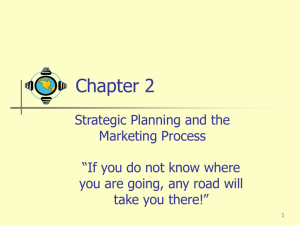Ch18 Organising and Planning for Effective Implementation A
advertisement
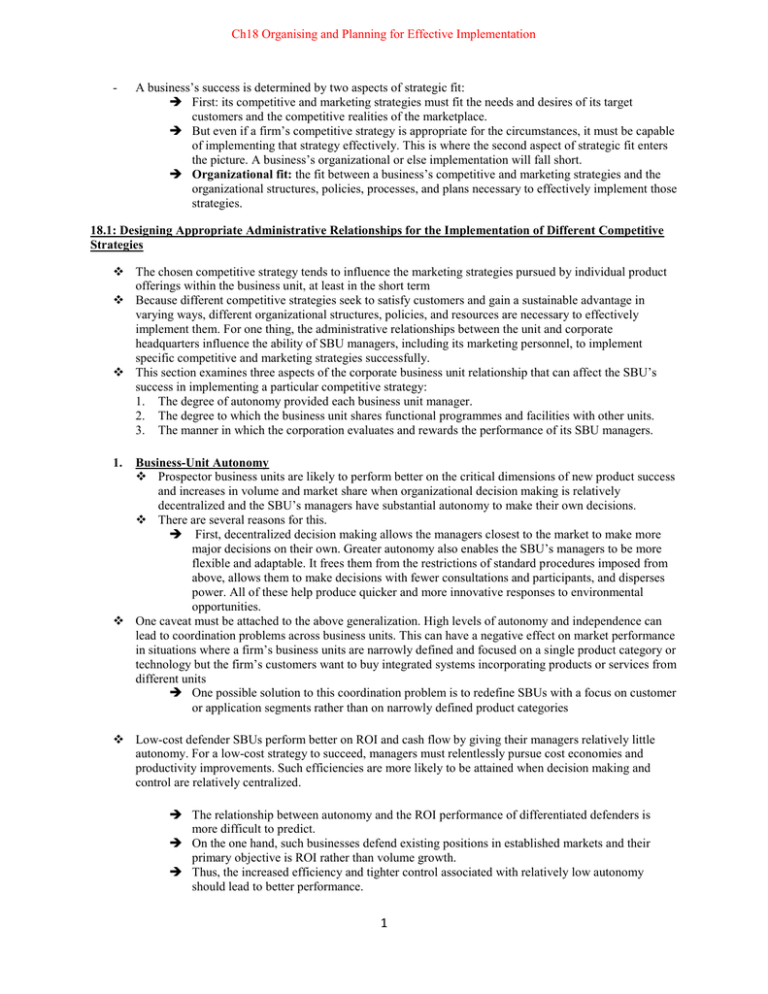
Ch18 Organising and Planning for Effective Implementation - A business’s success is determined by two aspects of strategic fit: First: its competitive and marketing strategies must fit the needs and desires of its target customers and the competitive realities of the marketplace. But even if a firm’s competitive strategy is appropriate for the circumstances, it must be capable of implementing that strategy effectively. This is where the second aspect of strategic fit enters the picture. A business’s organizational or else implementation will fall short. Organizational fit: the fit between a business’s competitive and marketing strategies and the organizational structures, policies, processes, and plans necessary to effectively implement those strategies. 18.1: Designing Appropriate Administrative Relationships for the Implementation of Different Competitive Strategies The chosen competitive strategy tends to influence the marketing strategies pursued by individual product offerings within the business unit, at least in the short term Because different competitive strategies seek to satisfy customers and gain a sustainable advantage in varying ways, different organizational structures, policies, and resources are necessary to effectively implement them. For one thing, the administrative relationships between the unit and corporate headquarters influence the ability of SBU managers, including its marketing personnel, to implement specific competitive and marketing strategies successfully. This section examines three aspects of the corporate business unit relationship that can affect the SBU’s success in implementing a particular competitive strategy: 1. The degree of autonomy provided each business unit manager. 2. The degree to which the business unit shares functional programmes and facilities with other units. 3. The manner in which the corporation evaluates and rewards the performance of its SBU managers. 1. Business-Unit Autonomy Prospector business units are likely to perform better on the critical dimensions of new product success and increases in volume and market share when organizational decision making is relatively decentralized and the SBU’s managers have substantial autonomy to make their own decisions. There are several reasons for this. First, decentralized decision making allows the managers closest to the market to make more major decisions on their own. Greater autonomy also enables the SBU’s managers to be more flexible and adaptable. It frees them from the restrictions of standard procedures imposed from above, allows them to make decisions with fewer consultations and participants, and disperses power. All of these help produce quicker and more innovative responses to environmental opportunities. One caveat must be attached to the above generalization. High levels of autonomy and independence can lead to coordination problems across business units. This can have a negative effect on market performance in situations where a firm’s business units are narrowly defined and focused on a single product category or technology but the firm’s customers want to buy integrated systems incorporating products or services from different units One possible solution to this coordination problem is to redefine SBUs with a focus on customer or application segments rather than on narrowly defined product categories Low-cost defender SBUs perform better on ROI and cash flow by giving their managers relatively little autonomy. For a low-cost strategy to succeed, managers must relentlessly pursue cost economies and productivity improvements. Such efficiencies are more likely to be attained when decision making and control are relatively centralized. The relationship between autonomy and the ROI performance of differentiated defenders is more difficult to predict. On the one hand, such businesses defend existing positions in established markets and their primary objective is ROI rather than volume growth. Thus, the increased efficiency and tighter control associated with relatively low autonomy should lead to better performance. 1 On the other hand, such businesses can maintain profitability only if they continue to differentiate themselves by offering superior products and services. As customers’ wants change and new competitive threats emerge, the greater flexibility and market focus associated with greater autonomy may allow these businesses to more successfully maintain their differentiated positions and higher levels of ROI over time. These arguments suggest that the relationship between autonomy and performance for differentiated defenders may be mediated by the level of stability in their environments and by the proportion of offensive or proactive marketing strategies they employ. 2. Shared Programs and Facilities Sharing resources poses a particular problem for prospector business units. The business would have to negotiate a production schedule for the new product, and it may not be able to produce adequate quantities as quickly as needed if other units sharing the plant are trying to maintain sufficient volumes of their own products. It also may be difficult to train salespeople on the new product or to motivate them to reduce the time spent on established products to push the new item. Sharing sales and distribution programmes across consumer package goods SBUs. Prospector’s new product may have an easier time obtaining retailer support and shelf space if its represented by salespeople who also sell established brands to the same retail outlets. The increased efficiencies gained through sharing functional programmes and facilities often boost the ROI performance of low-cost defender SBUs. The inflexibility inherent in sharing is usually not a major problem for such businesses because their markets and technologies tend to be mature and relatively stable. The impact of shared programmes on the performance of differentiated defenders is more difficult to predict because they often must modify their products and marketing programmes in response to changing market conditions to maintain their competitive advantage over time. Greater functional independence in areas directly related to the SBU’s differential advantage – such as R&D, sales, and marketing – tends to be positively associated with the long-run ROI performance of such businesses. But greater sharing of facilities and programmes in less-crucial functional areas, such as manufacturing or distribution, also may help improve their efficiency and short-run ROI levels. 3. Evaluation and Reward Systems SBU managers are often motivated to achieve their objective by bonuses or other financial incentives tied to one or more dimensions of their unit’s performance. Tying a relatively large portion of managers’ incentive compensation to short-term profits seems sensible. This can be done either through bonuses based on last year’s profit performance or economic value added(EVA) or through options keyed to increases in the firm’s stock price. In prospector businesses, on the other hand, basing too large a portion of managers’ rewards on current profitability may cause problems. Such rewards may motivate managers to avoid innovative but risky actions or investments that may not pay off for some years into the future. Even successful new product introductions can dramatically increase costs and drain profits early in the product’s life cycle. By the time the new product starts contributing to the unit’s profits, the manager who deserves the credit may have been transferred to a different business. Therefore, evaluation and reward systems that place relatively more emphasis on sales volume or market share objectives, or on the percentage of volume generated by new products, may be more appropriate for businesses pursuing prospector strategies. 18.2: Designing Appropriate Organization Structures and Processes for Implementing Different Strategies Successful implementation of a given strategy is more likely when the business has the functional competencies demanded by its strategy and supports them with substantial resources relative to competitors; is organized suitably for its technical, market, and competitive environment; and has developed appropriate mechanisms for coordinating efforts and resolving conflicts across functional departments. Exhibit 18.3 Organizational and interfunctional factors related to the successful implementation of business strategies Business strategies Organizational factor Prospector Differentiated defender Low-cost defender Functional competencies of the SBU SBU will perform best on critical volume and share-growth dimensions when its functional strengths include marketing, sales, SBU will perform best on critical ROI dimension when its functional strengths include sales, financial management and control SBU will perform best on critical ROI and cash-flow dimensions when its functional strengths include process engineering, 2 product R&D and engineering. and those functions related to its differential advantage (e.g. marketing, product R&D). production, distribution and financial management and control. Resource allocation across functions SBU will perform best on volume and share-growth dimensions when percentage of sales spent on marketing, sales and product R&D are high and when gross fixed assets per employee and percentage of capacity utilization are low relative to competitors’. SBU will perform best on the ROI dimension when percentage of sales spent on the salesforce, gross fixed assets per employee, percentage of capacity utilization and percentage of sales devoted to other functions related to the SBU’s differential advantage are high relative to competitors’. SBU will perform best on ROI and cash flow dimensions when marketing, sales and product R&D expenses are low, but process R&D, fixed assets per employee and percentage of capacity utilization are high relative to competitors’. Decision-making influence and participation SBU will perform best on volume and share-growth dimensions when managers from marketing, sales, product R&D and engineering have substantial influence on unit’s business and marketing-strategy decisions. SBU will perform best on ROI dimension when financial managers, controller and managers of functions related to unit’s differential advantage have substantial influence on business and marketing- strategy decisions. SBU will perform best on ROI and cash flow when controller, financial and production managers have substantial influence on business and marketing-strategy decisions. SBU’s organizational structure SBU will perform best on volume and share-growth dimensions when structure has low levels of formalization and centralization, but high level of specialization. SBU will perform best on ROI dimension when structure has moderate levels of formalization, centralization and specialization. SBU will perform best on ROI and cash flow dimensions when structure has high levels of formalization and centralization, but low level of specialization. Functional co-ordination and conflict resolution SBU will experience high levels of interfunctional conflict; SBU will perform best on volume and share-growth dimensions when participative resolution mechanisms are used (e.g. product teams). SBU will experience moderate levels of interfunctional conflict; SBU will perform best on ROI dimension when resolution is participative for issues related to differential advantage, but hierarchical for others (e.g. product managers, product improvement teams, etc.). SBU will experience low levels of interfunctional conflict; SBU will perform best on ROI and cashflow dimensions when conflictresolution mechanisms are hierarchical (e.g. functional organization). I. Functional Competencies and Resource Allocation Competence in marketing, sales, product R&D, and engineering is critical to the success of prospector businesses because those functions play pivotal roles in new product and market development and thus must be supported with budgets set at a larger percentage of sales than their competitors. Bottom-up strategic planning systems are particularly well-suited to prospector businesses operating in unstable environments. Success here is positively affected by the extent to which customer orientation is an integral part of the unit’s corporate culture. In low-cost defender businesses, on the other hand, the functional areas most directly related to operating efficiency, such as financial management and control, production, process R&D, and distribution or logistics, play the most crucial roles in enabling the SBU to attain good ROI performance. II. Additional Considerations for Service Organizations Service organizations pursue the same kinds of business-level competitive strategies as goods producers, they must meet the same functional and resource requirements to implement those strategies effectively. Service organizations – and manufacturers that provide high levels of customer service as part of their product offering – often need some additional functional competencies because of the unique problems involved in delivering quality service. This is particularly true for services involving high customer contact. Because the sale, production, and delivery of such services occur almost simultaneously, close coordination between operations, sales, and marketing is crucial. Also, because many different employees may be involved in producing and delivering the service production planning and standardization are needed to reduce variations in quality from one transaction to the next. Competence in human resource development is more crucial for service businesses pursuing prospector strategies- and perhaps also for defenders and analyzers who differentiate their offerings on the basis of good service- than for those focused primarily on efficiency and low cost. 3 In prospector service organizations, employees play a critical role in identifying potential new service offerings and in introducing them to potential customers. III. Organizational Structures Three structural variables – formalization, centralization, and specialization – are important in shaping both an SBU’s and its marketing department’s performance within the context of a given competitive strategy. Formalization is the degree to which formal rules and standard policies and procedures govern decisions and working relationships. Centralization refers to the location of decision authority and control within an organization’s hierarchy. In highly centralized SBUs or marketing departments, only one or a few top managers hold most decision-making authority. In more decentralized units, middle- and lowerlevel managers have more autonomy and participate in a wider range of decisions. Specialization refers to the division of tasks and activities across positions within the organizational unit. A highly specialized marketing department, for instance, has a large number of specialists, such as market researchers, advertising managers, and sales promotion managers, who perform a narrowly defined set of activities often as consultants to product managers. Highly structured business units and marketing departments are unlikely to be very innovative or quick to adapt to a changing environmental circumstance. Adaptiveness and innovativeness are enhanced when (1) decision-making authority is decentralized, (2) managerial discretion and informal coordination mechanisms replace rigid rules and policies, and (3) more specialists are present. Thus, prospector business units and their marketing departments are likely to perform better when they are decentralized, have little formalization, and are highly specialized. Differentiated defenders perform best when their organization structures incorporate moderate levels of formalization, centralization, and specialization. Several common organizational designs incorporate differences in both the structural variables (formalization, centralization, and specialization) and the mechanisms for resolving interfunctional conflicts. These include (1) functional, (2) product management, (3) market management, and (4) various types of matrix organizational designs. 1. Functional Organizations The functional form of organization is the simplest and most bureaucratic design. At the SBU level, managers of each functional department, such as production or marketing, report to the general manager. Within the marketing department, managers of specific marketing activity areas, such as sales, advertising, or marketing research, report to the marketing vice president or director. At each level the top manager coordinates the activities of all the functional areas reporting to him or her, often with heavy reliance on standard rules and operating procedures. This is the most centralized and formalized organization form and relies primarily on hierarchical mechanisms for resolving conflicts across functional areas. These characteristics make the functional form simple, efficient, and particularly suitable for companies operating in stable and slow-growth industries where the environments are predictable. Thus, the form is appropriate for low-cost defender SBUs attempting to maximize their efficiency and profitability in mature or declining industries. The simplicity of the functional organization also makes it the most common organizational form among entrepreneurial start-ups, including many dot-com companies. Even though the functional form is very hierarchical, such firms can still be nimble and innovative provided that (1) the company remains small enough that the entrepreneur can personally supervise and coordinate the various functions, (2) the firm is focused on a single product or product line targeted at one customer segment, and (3) the entrepreneur’s personal vision is an adequate source of innovation to differentiate the entire company. Exhibit 18.4: Functional Organization of an SBU and its marketing department. 4 2. Product Management Organizations This form adds an additional layer of managers to the marketing department, usually called product managers, brand managers, or marketing managers, each of whom has the responsibility to plan and manage the marketing programmes and to coordinate the activities of other functional departments for a specific product or product. A product management structure decentralizes decision making while increasing the amount of product specialization within the SBU. If the product managers also are given substantial autonomy to develop their own marketing plans and programmes, this structure also can decrease the formalization within the business. Finally, although the product managers are responsible for obtaining cooperation from other functional areas both within and outside the marketing department, they have no formal authority over these areas. They must rely on persuasion and compromise – in other words, more participative methods – to overcome conflicts and objections when coordinating functional activities. These factors make the product management form of organization less bureaucratic than the functional structure. It is more appropriate, then, for businesses pursuing differentiated defender and analyzer strategies, particularly when they operate in industries with complex and relatively unstable market and competitive environments. Product management organizations have a number of advantages, including the ability to identify and react more quickly to the threats and opportunities individual product-market entries face; improved coordination of functional activities within and across productmarkets; and increased attention to smaller product-market entries that might be neglected in a functional organization. a product management organization has shortcomings. The major one is the difficulty of obtaining the cooperation necessary to develop and implement effective programmes for a particular product given that a product manager has little direct authority. They increasingly must face the fact that customers can quickly compare products and prices – and even suggest their own price – over the Internet; that customers are becoming more price sensitive and less brand loyal; that competition is becoming more global; that rapidly changing technologies are providing new ways to improve production and distribution efficiency, but also shortening product life cycles; and that the power of large retailers and distributors has increased due in part to their ability to collect and control information about the marketplace. As a result of these trends and the inherent weakness of the product manager type of organization, many companies have undertaken two major types of modifications – market management and matrix organization. 5 3. Market Management Organizations A product manager has overall responsibility for planning and implementing a national marketing programme for the product, but several market mangers are also given some authority and an independent budget to work with salespeople and develop promotion programmes geared to a particular user segment or geographic market. This kind of decentralization or regionalization has become popular with consumer goods companies in their efforts to increase geographic segmentation and cope with the growing power of regional retail chains. 4. Matrix Organizations A business facing an extremely complex and uncertain environment may find a matrix organization appropriate. The matrix form is the least bureaucratic or centralized and the most specialized type of organization. It brings together two or more different types of specialists within a participative coordination structure. As a group, the team must agree on a business plan for the product and ensure the necessary resources and cooperation from each functional area. This kind of participative decision making can be very inefficient; it requires a good deal of time and effort for the team to reach mutually acceptable decisions and gain approval from all the affected functional areas. The matrix form of organization particularly suits prospector businesses and the management of new product development projects within analyzer or differentiated defender businesses. IV. Recent Trends in Organizational Design Organizations will increasingly emphasize the managing of business processes in contrast to functional areas. Every business has about six basic or core processes, such as, for example, new product development and supply chain management. The former would be staffed by individuals from marketing, R&D, manufacturing, and finance. The latter would contain people with expertise in purchasing, manufacturing, order delivery, and billing. Managing processes will make the organization essentially horizontal – flat and lean versus a vertical or hierarchical model. Thus, executive positions will no longer be defined in terms of managing a group of functionally oriented people; instead, executives will be concerned with a process that strongly emphasizes the importance of customer satisfaction. 6 Process management is quite different from the management of a function because: first, it uses external objectives, such as customer satisfaction versus simple revenues. Second, people with different skills are grouped to undertake a complete piece of work; their work is done simultaneously, not in sequence. Third, information flows directly to where it is used. Thus, if you have an upstream problem, you deal with people involved directly rather than via your boss. The use of self-managing teams is increasing. Regardless of the form of worker self-management, all are based on the concept or empowerment- the theory that those doing the work should have the means to do what it takes to please the customer. But many teams have failed because management was not serious about their empowerment, team members were poorly selected, or the team was launched in isolation with little training or support. In the future many companies will use teams as the basis for collaborative networks that link thousands or people together with the help of a variety of new technologies. Such networks enable businesses to form and dissolve relations quickly and to bring to bear on an opportunity or a threat the needed resources regardless of who owns them But not all such collaborative networks are successful, especially those involving joint ventures. Partnering is at best a difficult and demanding undertaking requiring considerable managerial skills as well as a great deal of trust. A major difficulty, especially for those involving companies from different parts of the world, is that ‘they cannot be controlled by formal systems, but require a dense web of interpersonal connections and internal infrastructures that enhance learning. V. Organizational Adjustments as Firms Grow and Markets Change As the number of customers and the range or product lines grow, the best way to organize the marketing and sales functions should be subject to change. How should managers decide when the time has come to restructure an organization, and what new structure should replace the old one? There are five key drivers in such decisions: (1) customer needs, (2) informational requirements of the sales and marketing personnel charged with meeting those needs, (3) ability of a given structure to motivate and coordinate the kinds of activities that market conditions require, (4) available competencies and resources, and (5) costs. When customer segments use goods or services in different ways, either a product-focused or marketfocused structure is likely to work well. When a company’s offerings are relatively simple and easy to understand, a single salesforce may be able to handle the entire line. But when products are technically complex or open to customization, each line may require its own specialized sales and marketing organization. When the firm is not well established or needs to educate potential buyers about the advantages of an innovative offering, it may need heavy incentives to encourage salespeople to expend the effort necessary to win new business. Under such circumstances, team-oriented selling arrangements are likely to be ineffectual. Finally, the fact that more highly specialized structures also tend to increase personnel and administrative costs should not be overlooked. Thus, growing firms or those serving rapidly changing markets are likely to need to rethink – and perhaps change – the structure of their sales and marketing organizations frequently. Such changes can be disruptive to both internal and customer relationships. VI. - - Organizational Designs for Selling in Global Markets An organization’s complexity increases, often quite dramatically, as it ‘goes international’ and especially so as overseas sales as a percentage of total sales increase. The issue is essentially one of deciding what organizational design is best for developing and implementing worldwide strategies while simultaneously maintaining flexibility with regard to individual markets. In evaluating the several types of international organizational structures discussed in this section, keep in mind two things: ‘first, that innovation is the key to success. An organization which relies on one culture for its ideas and treats foreign subsidiaries as dumb production-colonies might as well hire subcontractors. Second, technology is making the world smaller. Little or No Formal Organization Early on in a firm’s international involvement, the structure typically ranges from the domestic organization handling international transactions to a separate export department. The latter may be tied to the marketing department or may be a freestanding functional department. An International Division 7 - - An international division is often established to house all international activities, most of which relate to marketing. Manufacturing, engineering, finance, and R&D typically remain in their previous form to take advantage of scale effects. This type of organization serves best with a limited number of products that lack cultural sensitivity. Global Structures There are a variety of global types, of which the simplest replicates the firm’s basic functional departments. A global company using the functional type of organization would have vice presidents (worldwide) for such areas as manufacturing, marketing, and finance – all reporting to the president. By far the most common global structure is one based on products, which translates into giving SBUs worldwide control over their product lines. The main advantages of this type of structure are the economies derived from centralizing manufacturing activities and the ability to respond quickly to product-related problems originating in overseas markets. Marketing is usually localized at the country or regional level. The area structure is another popular global organizational type and is especially appropriate when there is considerable variance across markets regarding product acceptance and marketing activities. Some companies use a hybrid organization that typically is some combination of the functional, product, or area types of structure. The global matrix has individual business managers reporting to both area and functional groups, or area managers reporting to business and functional groups, thereby enabling the company to balance the need for centralized efficiency and its responsiveness to local needs. Decision Making and Organizational Structure Global organization structures can be centralized or decentralized in terms of decision making. In the case of the latter, controls are relatively simple and relations between subsidiaries and headquarters mainly financial. Local management is closest to the market and can respond quickly to change. But multinationals faced with strong global competition require more centralization, which calls for headquarters to provide the overall strategy that subsidiaries implement within a range agreed upon with headquarters. 18.3: Marketing Plans: The Foundation For Implementing Marketing Actions Preparation of a written plan is a key step in ensuring the effective execution of a strategic marketing programme because it spells out what actions are to be taken, when, and by whom. Written plans are particularly crucial in larger organizations because a marketing manager’s proposals must usually be reviewed and approved by higher levels of management, and because the approved plan then provides the benchmark against which the manager’s and the marketing programme’s performances will be evaluated. Preparing formal, written marketing plans, however brief, is a useful exercise even in small firms because the discipline involved helps ensures that the proposed objectives, strategy, and marketing actions are based on rigorous analysis of the 4 Cs and sound reasoning. Exhibit 18.8 Contents of an annual marketing plan Section Content I Executive summary Presents a short overview of the issues, objectives, strategy and actions incorporated in the plan and their expected outcomes for quick management review. II Current situation and trends Summarizes relevant background information on the market, competition and the macro environment, and trends therein, including size and growth rates for the overall market and key segments. III Performance review (for an existing product or service only) Examine the past performance of the product and the elements of its marketing programme (e.g. distribution, promotion, etc.). IV Key issues Identifies the main opportunities and threats to the product that the plan must deal with in the coming year and the relative strengths and weaknesses of the product and business unit that must be taken into account in facing those issues. V Objectives Specifies the goals to be accomplished in terms of sales volume, market share and profit. VI Marketing strategy Summarizes the overall strategic approach that will be used to meet the plan’s objectives. 8 VII Action plans This is the most critical section of the annual plan for helping to ensure effective implementation and coordination of activities across functional departments. It specifies: The target market to be pursued. What specific actions are to be taken. Who is responsible for each action. When the action will be engaged in. How much will be budgeted for each action. VIII Projected profit-and-loss statement Presents the expected financial payoff from the plan. IX Controls Discusses how the plan’s progress will be monitored; may present contingency plans to be used if performance falls below expectations or the situation changes. X Contingency plans Describes actions to be taken if specific threats or opportunities materialize during the planning period. The success of a marketing plan depends on effective communication with other parts of the organization (such as production, engineering, and R&D) and a variety of marketing units, especially those concerned with sales, advertising, promotions, and marketing research. By using the experience of others (as consultants) in preparing the action programmes (for instance, in-store promotions), the planner not only benefits from the expertise of specialists, but also increases their buy-in to the overall marketing plan, thereby increasing the likelihood of its success. The action programmes should reflect agreements made with other departments and marketing units as to their responsibilities over the planning period concerning the product. I. The Situational Analysis It is the “homework” portion of the plan where the manager summarizes his or her analysis of current and potential customers, the competitive environment and the company’s relative strengths and weaknesses, trends in the broader macro environment that may impact the product, and past performance outcomes for existing products. 1. Market Situation Data is presented on the target market. Total market size and growth trends should be discussed, along with any variations across geographic regions or other market segments. Marketing research information also might be presented concerning customer perceptions and buying-behavior trends. 2. Competitive Situation The product’s major competitors in terms of their size, market share, product quality, marketing strategies, and other relevant factors. Discuss the likelihood that other potential competitors will enter the market in the near future and the possible impact of such entry on the product’s competitive position. 3. Macro-environmental Situation Describes broad environmental occurrences or trends that may have a bearing on the product’s future. The issues include any relevant economic, technological, political/legal, or social/cultural changes. 4. Past Product Performance Discusses the product’s performance on such dimensions as sales volume, margins, marketing expenditures, and profit contribution for several recent years. This information is usually presented in the form of a table. The best way to determine a firm’s relative cost position is to use the value chain concept, which identifies “the activities, functions, and business processes that have to be performed in designing, producing, marketing, delivering, and supporting a product or service. The chain of value-creating activities starts with raw materials and continues on through parts and components production, manufacturing and assembly, wholesale distribution, and retailing to the ultimate end user of the product or service. Developing estimates for each value chain item is difficult and time consuming, especially so for estimating competitor’s costs. Even so, it is well worth the effort. 5. Sales Forecast and Other Key Assumptions 9 The assessment of the current situation also typically includes estimates of sales potential, sales forecasts, and other evidence or assumptions underlying the plan. Measurements are particularly critical as the foundation for marketing plans for new goods or services where there is no past history to draw on. Exhibit 18.11 Historical and projected financial performance of refrigerated bread dough product Variable Last year This year Percentage change Next year Percentage change Sales volume (cases) 2 290m 2 350m +3% 2 300m (2%) Net sales ($) 17 078m 21 165m +24 21 182m 0 Gross margin ($) 6 522m 10 787m +65 11 430m +5 Gross margin/net sales 38% 51% – 54% – Advertising and sales promotion ($) 11 609m 12 492m +6 6 100m (51) Advertising and sales promotion/gross margin 178% 116% – 53% – Net margin ($) (5 087m) (1 705m) – 5 330m – Net margin/net sales – – – 25 – Product contribution ($) (6 342m) (3 740m) – 4 017m – II. Key Issues Issues represent either threats to the future market or financial performance of the product or opportunities to improve those performances. III. Objectives Information about the current situation, the product’s recent performance, and the key issues to be addressed now serve as the basis for setting specific objectives for the coming year. Two types of objectives need to be specified. Financial objectives provide goals for the overall performance of the brand and should reflect the objectives for the SBU as a whole and its competitive strategy. Those financial goals must then be converted into marketing objectives that specify the changes in customer behavior and levels of performance of various marketing programme elements necessary to reach the product’s financial objectives. IV. Marketing Strategy The chosen strategy should fit the market and competitive conditions faced by the product and its strategic objectives. It also should incorporate all of the necessary decisions concerning the 4Ps. The RBD product manager recommends that a maintenance strategy be pursued. The intense competitive situation, uncertainty over the possible entry of Merico, and the past inability of primary-demand advertising to increase market penetration all suggest that it would be difficult to expand RBD’s market by simply doing more of the same. The recommended strategy seeks to maintain or slightly increase RBD volume and share primarily by stimulating repeat purchases among current customers. Reductions in advertising expenditures and continued improvements in manufacturing costs will be relied on to help the brand achieve its profit contribution objective. It is recommended that development and test marketing of several line extensions (for example, whole wheat and a French-style loaf) be initiated in an attempt to identify viable opportunities for future volume expansion. V. Action Plans The action plan is the most crucial part of the annual marketing plan for ensuring proper execution. The specific actions necessary to implement the strategy for the product are listed, together with a clear statement of who is responsible for each action, when it will be done, and how much is to be spent on each activity. Actions requiring the cooperation of other functional departments should be included, but only after the product manager has contacted the departments involved, worked out any potential conflicts, and received assurances of support. 10 VI. Projected Profit-and-Loss Statement The action plan includes a supporting budget that is essentially a projected profit-and-loss statement. On the revenue side, it forecasts next year’s sales volume in units and dollars. On the expense side, it reflects manufacturing, distribution, and marketing costs associated with the planned actions. This budget is then presented to higher levels of management for review and possible modification. Once approved, the product’s budget serves as a basis for the plans and resource allocation decisions of other functional departments within the SBU. VII. Contingency Plans Finally, the manager might detail contingency plans to be implemented if specific threats or opportunities should occur during the planning period. The RBD product manager, recommended that no changes should be made in the product’s overall marketing strategy nor in its pricing or promotion tactics. 11
